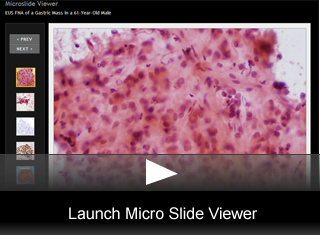EUS FNA of a Gastric Mass in a 61-Year-Old Male
by Magda Esebua, MD, Assistant Professor of Pathology, University of Missouri-Columbia
Editor: Brian T. Collins, MD, Professor of Pathology,University of Utah, and Medical Director, Cytopathology, ARUP Laboratories
A 61 year old white male presented with abdominal pain and early satiety. There was no chest pain, reflux, or shortness of breath. Physical exam revealed no palpable abdominal masses.
As part of the workup, esophagogastroduodenoscopy was performed, revealing a gastric sub-mucosal mass at the antrum measuring 3.5 cm. This mass was arising from muscularis propria and had two lobules. Endoscopic ultrasound-guided fine needle aspiration (EUS FNA) was performed. Six alcohol fixed slides and 30 cc of cytolyte were sent to cytology lab for proccessing and examination.
EUS FNA cytology of the gastric mass showed a large cell neoplasm most consistent with gastrointestinal stromal tumor. Approximately two months later a partial gastrectomy was performed and the specimen was sent for histologic evaluation.
Pathologic Findings
Cytologic Features:
- The cytology laboratory received 6 alcohol fixed smears and 30 cc of cytolyte. Papanicolaou stained smears; one cell block and one liquid-based slide were prepared. Papanicolaou stained smears showed a cellular sample composed of loosely cohesive groups of neoplastic cells. These neoplastic cells were predominantly epitheliod with eccentric oval to round nuclei and moderate to abundant eosinophilic or amphophilic granular cytoplasm with ill defined borders (fig. 1).
- Cells were imbedded in myxoid stroma and rare transgressing capillaries were noted. Prominent intranuclear inclusions and binucleation were present (fig. 2).
- The cell block preparation was moderately cellular; cells were arranged in sheets and showed cytologic features similar to what was present on the slides.
- An immunocytochemical panel using serveral antibodies was performed: CD117(c-kit), CD-34, smooth muscle actin (SMA), S-100, MART-1, CK-7 and CK-20, LCA.(fig. 3).
- Neoplastic cells were negative for CD117, S-100, A-103, CK-7, CK-20 and LCA. Neoplastic cells were positive for CD-34 (fig. 4).
Histologic Features:
- Partial gastrectomy specimen received in histology lab showed an endophytic submucosal neoplasm. (fig. 5).
- Sectioning revealed 3.5 by 3.2 by 3.0 cm multi-lobulated well circumscribed tan-gray tumor confined to the wall of the stomach.
- Hematoxylin & Eosin stained slides show a neoplasm composed of predominantly large epitheliod cells with pleomorphic nuclei, prominent small nucleioli and abundant eosinophilic to clear cytoplasm.(fig. 6).
- Binucleation as well as multi-nucleation were noted. Occasional cytoplasmic vacuoles and intranuclear inclusions were also present. One mitosis was identified per 50 400X high power fields. No necrosis was seen.
- Immunohistochemical stains were as follows; CD117 negative (fig. 7) CK, Vimentin, EMA, CD-31, Mart-1, HMB-45 and S-100 negative; CD-34 positive,(fig. 8), and SMA weakly positive.
Final Diagnosis & Discussion
© The copyright for photographs and digital images shown in this case report is owned jointly by Brian Collins, MD and ARUP Laboratories, Inc. Unlicensed publication in print, on the internet, or in any other media form of these digital images or photomicrographs for any purpose without written permission is strictly prohibited. Limited use for teaching is permitted. Please contact The Webmaster for licenses and permissions. If you wish to use these images as aid in lectures or scientific slide presentations, each image should accompany the following text: "copyrighted material: www.arup.utah.edu"
 Site Search
Site Search


